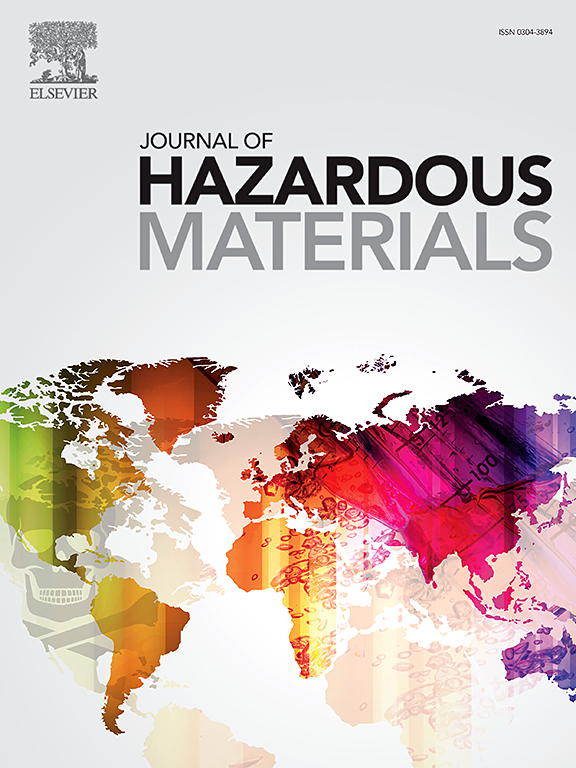基于离子液体杂化多金属氧酸盐的深度共晶溶剂的高效H2S捕获:构象转变和构效关系的见解
IF 11.3
1区 环境科学与生态学
Q1 ENGINEERING, ENVIRONMENTAL
引用次数: 0
摘要
虽然多金属氧酸盐(POM)与绿色溶剂的结合引起了人们的极大兴趣,但在非水溶剂中的脱硫应用仍然是一个挑战,而且对反应机理和构象的贡献仍然缺乏系统的了解。本文以烷基长链离子液体杂化多金属氧酸盐(POM-ILs)和基于il的深共晶溶剂(DES)两种离子液体为背景,设计构建了长链离子液体杂化多金属氧酸盐深共晶溶剂(PCDES)体系,实现了POM-ILs杂化材料的液相脱硫应用。在密度泛函理论(DFT)计算和表征分析的指导下,首次提出了“三叶草”构象过渡理论来解释PCDES的脱硫机理。脱硫活性位点的暴露、硫化氢(H2S)捕获范围的扩大以及电荷链转移行为是提高PCDES脱硫性能的关键因素。最佳脱硫剂PCDES@3C14-2Im在25 ~ 200℃的较宽温度范围内,脱硫效率可保持100%近150 min。此外,加入过氧化氢(H2O2)可实现脱硫剂的完全再生,多次循环后脱硫效率仍可保持在98%以上。最终脱硫产物为硫酸盐,满足绿色工程框架下H2S的无害化处理。本研究促进了多金属氧酸盐化学与绿色溶剂的深度融合应用,为研究多金属氧酸盐非水液相脱硫剂的结构-性能关系开辟了新的视角。考虑到当前环境保护的迫切需求,H2S的处理具有重要的现实意义。本研究提出的PCDES系统通过独特的“核壳”到“三叶草”的构象转变,在宽温度范围内实现了高效的H2S捕获和转化。将H2S转化为稳定环保的硫酸盐,实现H2S的绿色闭环处理。减少了化学试剂的使用,减少了资源消耗和环境负担。该方案为高效大气污染治理技术提供了新的视角,有望突破传统湿法氧化脱硫的技术瓶颈。本文章由计算机程序翻译,如有差异,请以英文原文为准。

Highly-efficient H2S capture by deep eutectic solvents based on ionic liquid hybridized polyoxometalate: Insights into conformational transitions and structure-activity relationships
While the combination of polyoxometalates (POM) with green solvents has attracted considerable interest, the application of desulfurization in non-aqueous solvents remains a challenge, and a systematic understanding of the reaction mechanism and the conformational contributions is still lacking. Herein, the long-chain ionic liquids hybrid polyoxometalates deep eutectic solvents (PCDES) system was designed and constructed by combining two materials possessing the background of ionic liquid (ILs), alkyl long-chain ionic liquids hybrid polyoxometalates (POM-ILs) and ILs-based deep eutectic solvents (DES), to realize the liquid-phase desulfurization application of POM-ILs hybrid materials. Guided by density functional theory (DFT) calculations and characterization analyses, the “cloverleaf” conformational transition theory was firstly proposed to explain the desulfurization mechanism of PCDES. The exposure of the desulfurization active site, the expansion of the hydrogen sulfide (H2S) capturing range, and the charge chain transfer behavior are the critical success factors for the enhancement of the PCDES desulfurization performance. The optimal desulfurizer PCDES@3C14-2Im can be maintained at 100% desulfurization efficiency for nearly 150 min over a wide temperature range of 25-200 oC. Furthermore, the complete regeneration of the desulfurizer can be realized by adding hydrogen peroxide (H2O2), and more than 98% desulfurization efficiency can still be maintained after multiple cycles. The final desulfurization product is sulphate, which satisfies the harmless treatment of H2S under the framework of green engineering. This work facilitates the deep fusion applications of polyoxometalate chemistry with green solvents and opens a fresh perspective for the investigation of structure-performance relationships of polyoxometalate non-aqueous liquid-phase desulfurizers.
Environmental Implication
Considering the current urgent demand for environmental protection, the treatment of H2S holds significant practical importance. The PCDES system proposed in this study achieves efficient H2S capture and conversion in a wide temperature range through a unique “core-shell” to “cloverleaf” conformational transition. H2S is converted into stable and environmentally friendly sulfate, realizing the green closed-loop treatment of H2S. It reduces the use of chemical reagents, resource consumption and environmental burden. This proposal offers a new perspective on efficient air pollution control technology and is expected to overcome the technical bottlenecks of traditional wet oxidation desulfurization.求助全文
通过发布文献求助,成功后即可免费获取论文全文。
去求助
来源期刊

Journal of Hazardous Materials
工程技术-工程:环境
CiteScore
25.40
自引率
5.90%
发文量
3059
审稿时长
58 days
期刊介绍:
The Journal of Hazardous Materials serves as a global platform for promoting cutting-edge research in the field of Environmental Science and Engineering. Our publication features a wide range of articles, including full-length research papers, review articles, and perspectives, with the aim of enhancing our understanding of the dangers and risks associated with various materials concerning public health and the environment. It is important to note that the term "environmental contaminants" refers specifically to substances that pose hazardous effects through contamination, while excluding those that do not have such impacts on the environment or human health. Moreover, we emphasize the distinction between wastes and hazardous materials in order to provide further clarity on the scope of the journal. We have a keen interest in exploring specific compounds and microbial agents that have adverse effects on the environment.
 求助内容:
求助内容: 应助结果提醒方式:
应助结果提醒方式:


